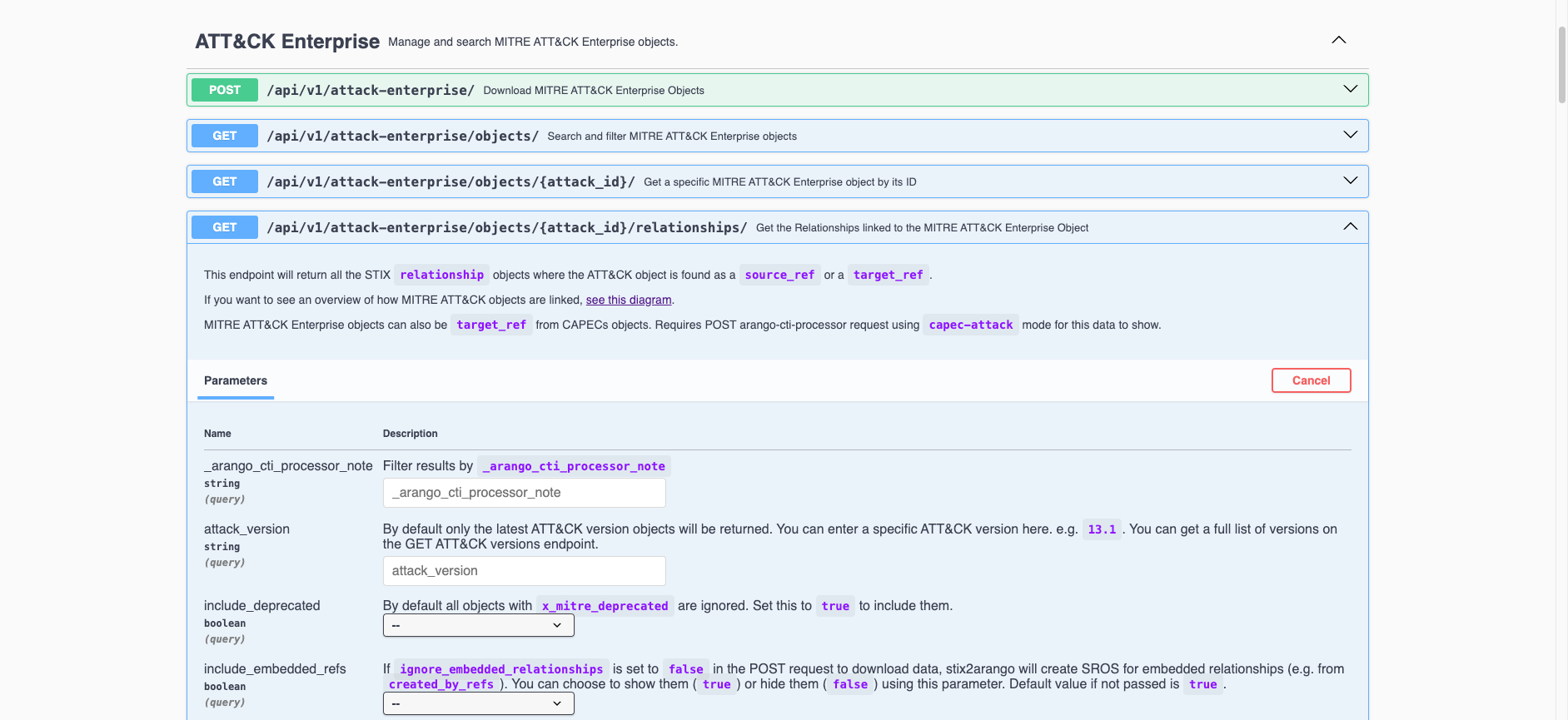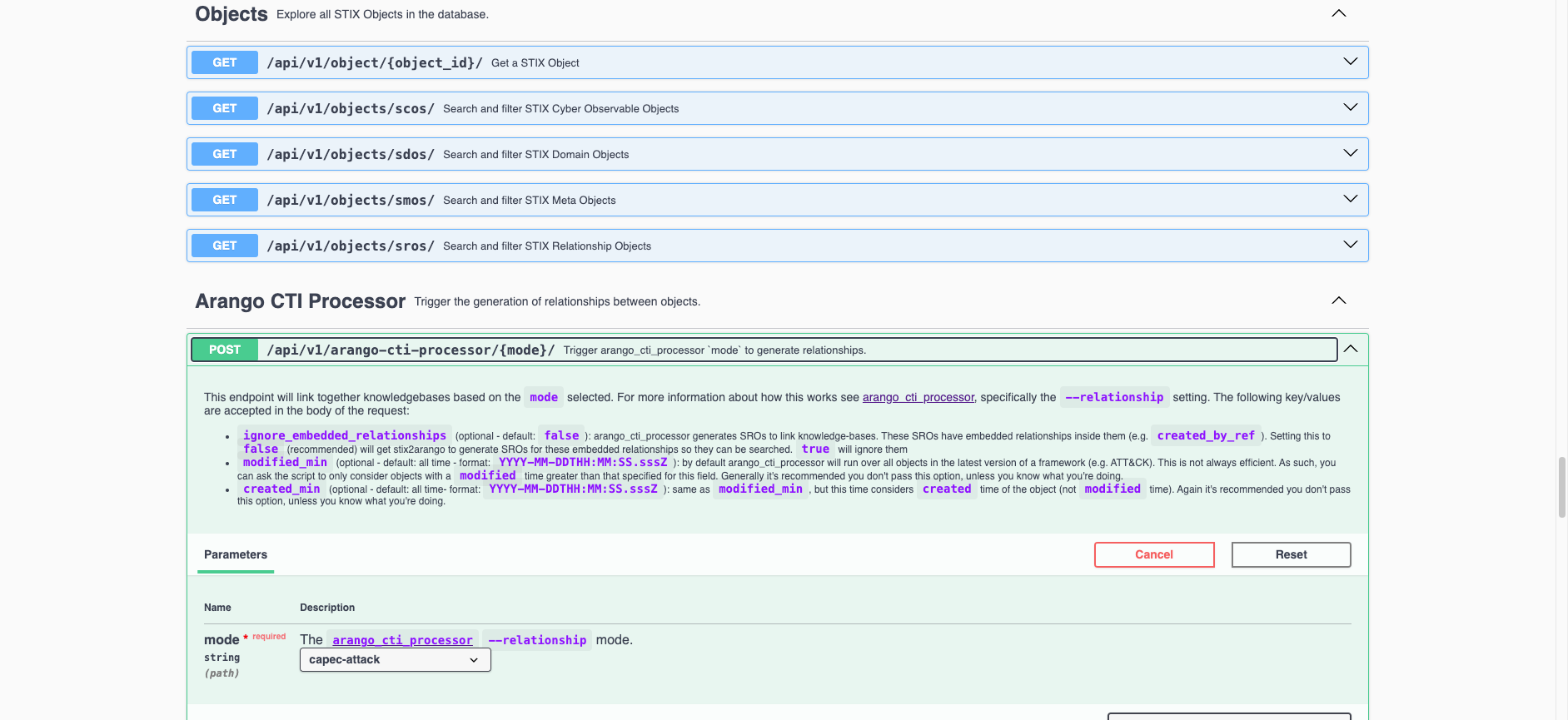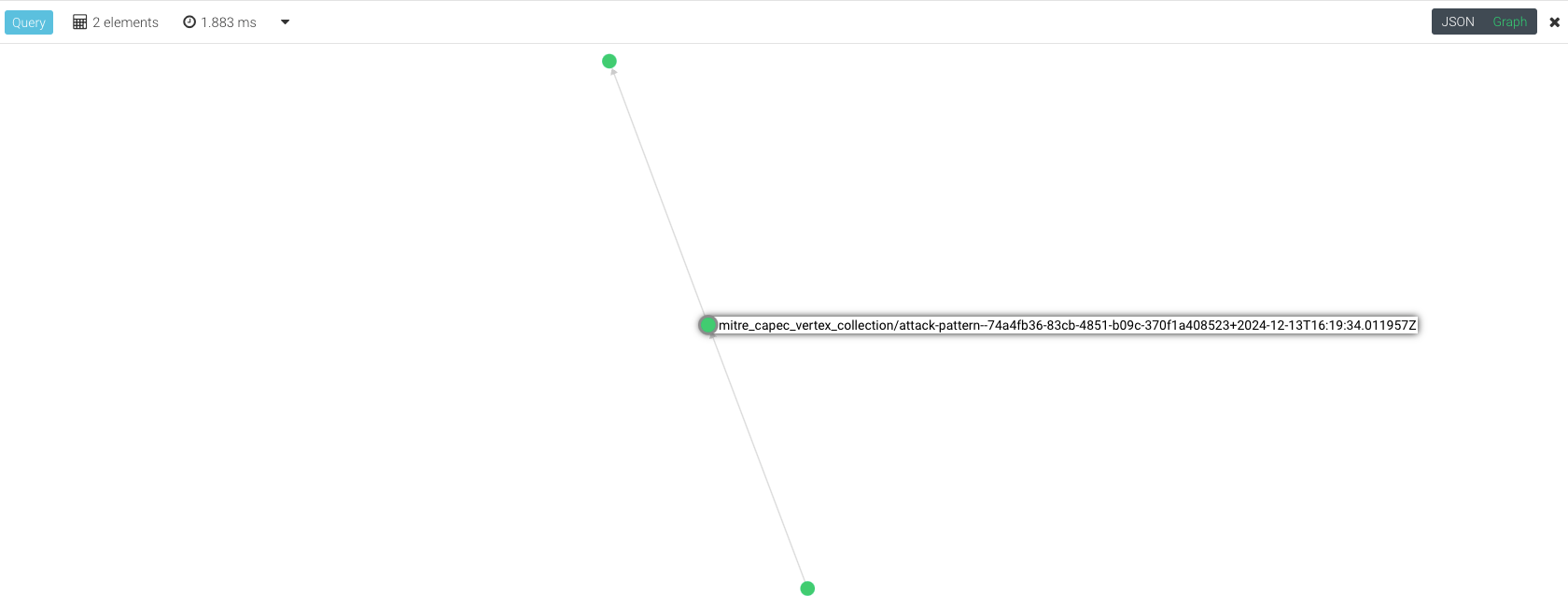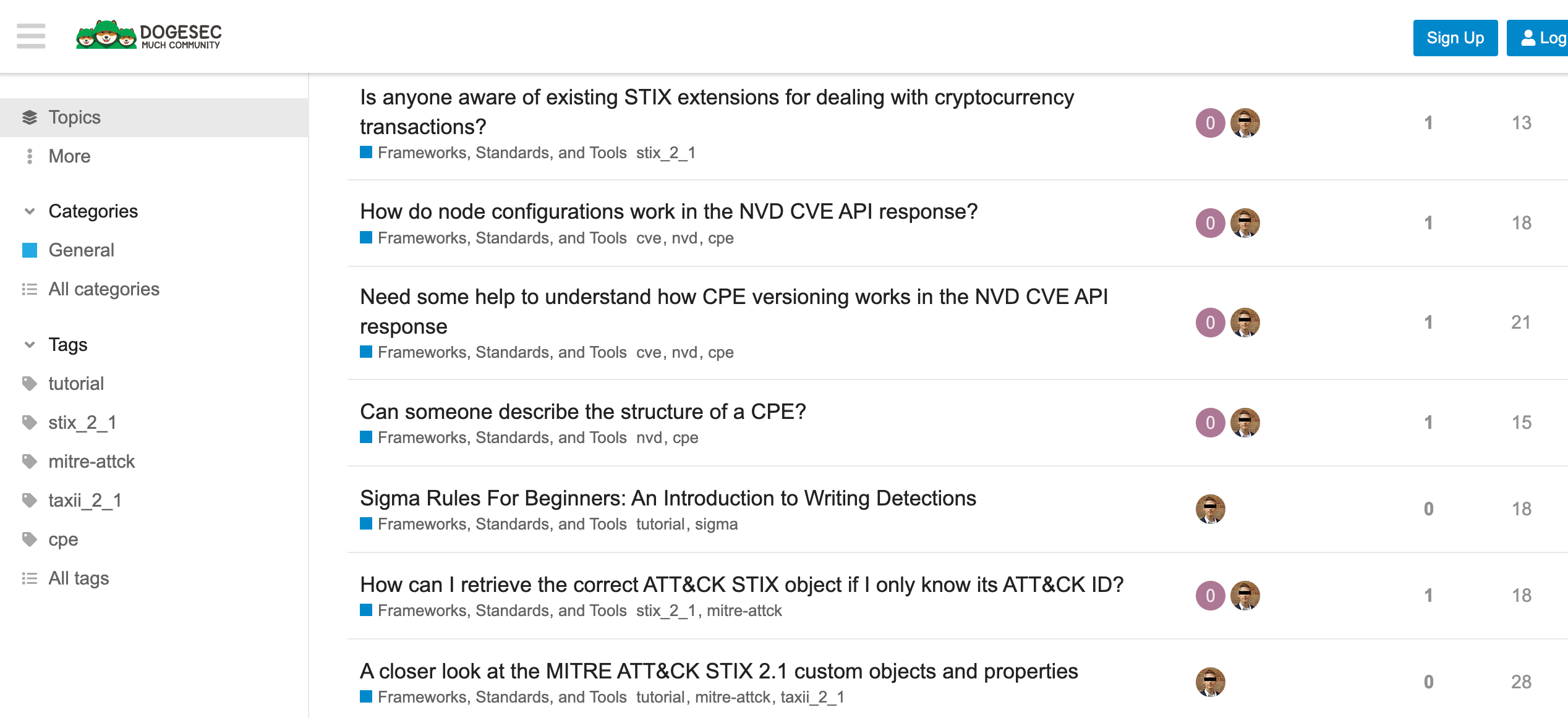If you are reading this blog post via a 3rd party source it is very likely that many parts of it will not render correctly (usually, the interactive graphs). Please view the post on dogesec.com for the full interactive viewing experience.
tl;dr
CTI Butler links many common knowledge bases, for example linking MITRE ATT&CK to CAPEC objects, to improve the context of our research. This post describes the logic CTI Butler employs behind the scenes to do this.
Overview
A lot of our tooling uses data held in CTI Butler Web to enrich our intelligence research.
One of the most used features is finding relationships for objects in each knowledgebase, like MITRE ATT&CK Enterprise.

This allows users to not only link their research to a single object (i.e. ATT&CK Technique), but also finds all related objects to the source object (Technique in this example) which could also be useful to include in their reporting.
Under the hood, CTI Butler uses arango_cti_processor to manage these relationships.

In this post I want to lift the lid and show you how arango_cti_processor works so you know how CTI Butler works.
CTI Butler knowledgebases
At the time of writing CTI Butler supports the following datasets;
- MITRE ATT&CK Enterprise
- MITRE ATT&CK ICS
- MITRE ATT&CK Mobile
- MITRE CAPEC
- MITRE CWE
- MITRE ATLAS
- DISARM
Any relationships that exist in these bundles will be searchable in CTI Butler without arango_cti_processor, e.g.
curl -X 'GET' \
'http://127.0.0.1:8006/api/v1/attack-enterprise/objects/t1049/relationships/' \
-H 'accept: application/json'
{
"page_size": 50,
"page_number": 1,
"page_results_count": 50,
"total_results_count": 99,
"relationships": [
{
"created": "2020-11-17T19:32:21.422Z",
"created_by_ref": "identity--c78cb6e5-0c4b-4611-8297-d1b8b55e40b5",
"description": "[Lucifer](https://attack.mitre.org/software/S0532) can identify the IP and port numbers for all remote connections from the compromised host.(Citation: Unit 42 Lucifer June 2020)",
"external_references": [
{
"source_name": "Unit 42 Lucifer June 2020",
"url": "https://unit42.paloaltonetworks.com/lucifer-new-cryptojacking-and-ddos-hybrid-malware/",
"description": "Hsu, K. et al. (2020, June 24). Lucifer: New Cryptojacking and DDoS Hybrid Malware Exploiting High and Critical Vulnerabilities to Infect Windows Devices. Retrieved November 16, 2020."
}
],
"id": "relationship--0d1fe44d-a476-4553-b163-1e03890ae7b4",
"modified": "2020-11-17T20:00:08.135Z",
"object_marking_refs": [
"marking-definition--fa42a846-8d90-4e51-bc29-71d5b4802168"
],
"relationship_type": "uses",
"source_ref": "malware--54a73038-1937-4d71-a253-316e76d5413c",
"spec_version": "2.1",
"target_ref": "attack-pattern--7e150503-88e7-4861-866b-ff1ac82c4475",
"type": "relationship",
"x_mitre_attack_spec_version": "2.1.0",
"x_mitre_domains": [
"enterprise-attack"
],
"x_mitre_modified_by_ref": "identity--c78cb6e5-0c4b-4611-8297-d1b8b55e40b5",
"x_mitre_version": "1.0"
},
T1049 (System Network Connections Discovery) has Relationships to 99 objects in the ATT&CK Enterprise bundle. The first result above shows the Malware S0532 (Lucifer) uses this Technique.
However, in this post I will show you the external joins, to other bundles. e.g. adding the filter ?_arango_cti_processor_note=capec-attack to search for relationships between T1049 and any CAPEC objects…
curl -X 'GET' \
'http://127.0.0.1:8006/api/v1/attack-enterprise/objects/t1049/relationships/?_arango_cti_processor_note=capec-attack' \
-H 'accept: application/json'
{
"page_size": 50,
"page_number": 1,
"page_results_count": 1,
"total_results_count": 1,
"relationships": [
{
"created": "2014-06-23T00:00:00.000Z",
"created_by_ref": "identity--2e51a631-99d8-52a5-95a6-8314d3f4fbf3",
"description": "CAPEC-309 uses technique T1049",
"id": "relationship--d1d052a1-4296-582e-be12-1b31a3f2a42b",
"modified": "2022-09-29T00:00:00.000Z",
"object_marking_refs": [
"marking-definition--94868c89-83c2-464b-929b-a1a8aa3c8487",
"marking-definition--2e51a631-99d8-52a5-95a6-8314d3f4fbf3"
],
"relationship_type": "technique",
"source_ref": "attack-pattern--fd114e53-fdc0-4eef-8254-40ef0d4ea482",
"target_ref": "attack-pattern--7e150503-88e7-4861-866b-ff1ac82c4475",
"type": "relationship"
}
]
}
Here I can see CAPEC-309 uses technique T1049.
Let me show you how these are created…
Follow along
If you’d like to follow along with the queries used in this post, you can use some utility scripts in stix2arango.
Once stix2arango is installed, run;
python3 utilities/arango_cti_processor/insert_archive_attack_enterprise.py \
--database blog_demo \
--ignore_embedded_relationships && \
python3 utilities/arango_cti_processor/insert_archive_attack_ics.py \
--database blog_demo \
--ignore_embedded_relationships && \
python3 utilities/arango_cti_processor/insert_archive_attack_mobile.py \
--database blog_demo \
--ignore_embedded_relationships && \
python3 utilities/arango_cti_processor/insert_archive_capec.py \
--database blog_demo \
--ignore_embedded_relationships && \
python3 utilities/arango_cti_processor/insert_archive_cwe.py \
--database blog_demo \
--ignore_embedded_relationships && \
python3 utilities/arango_cti_processor/insert_archive_disarm.py \
--database blog_demo \
--ignore_embedded_relationships && \
python3 utilities/arango_cti_processor/insert_archive_atlas.py \
--database blog_demo \
--ignore_embedded_relationships
This will store all current and historic versions of the knowledgebases in an ArangoDB database called; blog_demo_database, with the following Collections;
- MITRE ATT&CK Enterprise (
mitre_attack_enterprise_vertex_collection/mitre_attack_enterprise_edge_collection) - MITRE ATT&CK ICS (
mitre_attack_ics_vertex_collection/mitre_attack_ics_edge_collection) - MITRE ATT&CK Mobile (
mitre_attack_mobile_vertex_collection/mitre_attack_mobile_edge_collection) - MITRE CAPEC (
mitre_capec_vertex_collection/mitre_capec_edge_collection) - MITRE CWE (
mitre_cwe_vertex_collection/mitre_cwe_edge_collection) - MITRE ATLAS (
mitre_atlas_vertex_collection/mitre_atlas_edge_collection) - DISARM (
disarm_vertex_collection/disarm_edge_collection)
Note, the *_edge collections hold STIX Relationship objects from the knowledge-base bundles (in addition to the ones created by stix2arango, as described in this post), and the *_vertex collections hold all the other STIX objects present in the bundles.
Examining the joins
stix2arango will import the data to ArangoDB, but the knowledgebases are not connected in any way… yet.
If I look inside an object, I can see references between knowledgebases though.
For example, CAPECs reference MITRE ATT&CK Techniques and CWE’s. Take CAPEC-11 which references CWE-430 and T1036.006;
{
"created": "2014-06-23T00:00:00.000Z",
"created_by_ref": "identity--e50ab59c-5c4f-4d40-bf6a-d58418d89bcd",
"description": "An attack of this type exploits a Web server's decision to take action based on filename or file extension. Because different file types are handled by different server processes, misclassification may force the Web server to take unexpected action, or expected actions in an unexpected sequence. This may cause the server to exhaust resources, supply debug or system data to the attacker, or bind an attacker to a remote process.",
"external_references": [
{
"external_id": "CAPEC-11",
"source_name": "capec",
"url": "https://capec.mitre.org/data/definitions/11.html"
},
{
"external_id": "CWE-430",
"source_name": "cwe",
"url": "http://cwe.mitre.org/data/definitions/430.html"
},
{
"description": "Masquerading: Space after Filename",
"external_id": "T1036.006",
"source_name": "ATTACK",
"url": "https://attack.mitre.org/wiki/Technique/T1036/006"
},
{
"description": "G. Hoglund, G. McGraw, Exploiting Software: How to Break Code, 2004--02, Addison-Wesley",
"external_id": "REF-1",
"source_name": "reference_from_CAPEC"
},
{
"description": "Orion Application Server JSP Source Disclosure Vulnerability (Bugtraq ID: 17204), SecurityFocus",
"external_id": "REF-6",
"source_name": "reference_from_CAPEC",
"url": "http://www.securityfocus.com/bid/17204/info"
}
],
"id": "attack-pattern--74a4fb36-83cb-4851-b09c-370f1a408523",
"modified": "2022-09-29T00:00:00.000Z",
"name": "Cause Web Server Misclassification",
"object_marking_refs": [
"marking-definition--17d82bb2-eeeb-4898-bda5-3ddbcd2b799d"
],
"spec_version": "2.1",
"type": "attack-pattern",
"x_capec_abstraction": "Detailed",
"x_capec_child_of_refs": [
"attack-pattern--95afb65f-ece7-4511-85a3-d7bfb9973022"
],
"x_capec_consequences": {
"Access_Control": [
"Gain Privileges"
],
"Authorization": [
"Gain Privileges"
],
"Confidentiality": [
"Read Data",
"Gain Privileges"
]
},
"x_capec_domains": [
"Software"
],
"x_capec_likelihood_of_attack": "Medium",
"x_capec_prerequisites": [
"Web server software must rely on file name or file extension for processing.",
"The attacker must be able to make HTTP requests to the web server."
],
"x_capec_resources_required": [
"None: No specialized resources are required to execute this type of attack."
],
"x_capec_skills_required": {
"Low": "To modify file name or file extension",
"Medium": "To use misclassification to force the Web server to disclose configuration information, source, or binary data"
},
"x_capec_status": "Draft",
"x_capec_typical_severity": "High",
"x_capec_version": "3.9"
}
Using this data, I can programmatically generated edges in the graph database (that is what arango_cti_processor does) to link them.
Here is how arango_cti_processor identifies these references to link the knowledgebases…
1. CAPEC -> ATT&CK
Firstly, lets look at all CAPEC objects in v3.9 (latest version at time of writing);
LET results = (
FOR doc IN mitre_capec_vertex_collection
FILTER doc._stix2arango_note == "v3.9"
AND doc.revoked != true
COLLECT type = doc.type WITH COUNT INTO typeCount
RETURN { type, typeCount }
)
LET totalSum = SUM(FOR result IN results RETURN result.typeCount)
RETURN APPEND(results, [{ type: "Total", typeCount: totalSum }])
[
[
{
"type": "attack-pattern",
"typeCount": 615
},
{
"type": "course-of-action",
"typeCount": 877
},
{
"type": "identity",
"typeCount": 1
},
{
"type": "marking-definition",
"typeCount": 1
},
{
"type": "Total",
"typeCount": 1494
}
]
]
Lets now filter the results to only Objects with ATTACK references;
RETURN (
FOR doc IN mitre_capec_vertex_collection
FILTER doc._stix2arango_note == "v3.9"
AND doc.revoked != true
LET capecId = (
FOR reference IN (IS_ARRAY(doc.external_references) ? doc.external_references : [])
FILTER reference.source_name == 'capec'
RETURN reference.external_id
)
LET attackIds = (
FOR reference IN (IS_ARRAY(doc.external_references) ? doc.external_references : [])
FILTER reference.source_name == 'ATTACK'
RETURN reference.external_id
)
FILTER LENGTH(attackIds) > 0 AND LENGTH(capecId) > 0
RETURN {
stixObjectId: doc.id,
capecId: capecId[0],
attackIds: CONCAT_SEPARATOR(",", attackIds)
}
)
[
[
{
"stixObjectId": "attack-pattern--92cdcd3d-d734-4442-afc3-4599f261498b",
"capecId": "CAPEC-1",
"attackIds": "T1574.010"
},
{
"stixObjectId": "attack-pattern--74a4fb36-83cb-4851-b09c-370f1a408523",
"capecId": "CAPEC-11",
"attackIds": "T1036.006"
},
{
"stixObjectId": "attack-pattern--7b423196-9de6-400f-91de-a1f26b3f19f1",
"capecId": "CAPEC-112",
"attackIds": "T1110"
},
This should return 177 results of CAPEC objects, some having multiple attackIds referenced.
One thing I now know is the CAPEC objects only link to ATT&CK Techniques and Sub-Techniques.
This gives us a base search for the ATT&CK knowledge base as follows;
FOR doc IN UNION(
(FOR d IN mitre_attack_enterprise_vertex_collection RETURN d),
(FOR d IN mitre_attack_ics_vertex_collection RETURN d),
(FOR d IN mitre_attack_mobile_vertex_collection RETURN d)
)
FILTER doc._stix2arango_note == "v14.1"
AND doc.x_mitre_deprecated != true
AND doc.revoked != true
AND doc.type == "attack-pattern"
RETURN [doc]
Should return 820 STIX objects.
Now I can use the ATT&CK IDs in these objects, returned by the CAPEC search to find the STIX ID of the ATT&CK object and create the joins;
RETURN (
FOR doc IN mitre_capec_vertex_collection
FILTER doc._stix2arango_note == "v3.9"
AND doc.revoked != true
AND IS_ARRAY(doc.external_references)
LET capecId = FIRST(
FOR reference IN doc.external_references
FILTER reference.source_name == 'capec'
RETURN reference.external_id
)
LET attackIds = (
FOR reference IN doc.external_references
FILTER reference.source_name == 'ATTACK'
RETURN reference.external_id
)
FILTER LENGTH(attackIds) > 0 AND capecId != null
LET attackIdToDocIdMap = (
FOR attackId IN attackIds
LET attackDocs = (
FOR attackDoc IN UNION(
FOR d IN mitre_attack_enterprise_vertex_collection
FILTER d._stix2arango_note == "v14.1"
AND d.x_mitre_deprecated != true
AND d.revoked != true
AND d.type == "attack-pattern"
AND POSITION(d.external_references[*].external_id, attackId)
RETURN { id: d.id, collection: "mitre_attack_enterprise_vertex_collection" },
FOR d IN mitre_attack_ics_vertex_collection
FILTER d._stix2arango_note == "v14.1"
AND d.x_mitre_deprecated != true
AND d.revoked != true
AND d.type == "attack-pattern"
AND POSITION(d.external_references[*].external_id, attackId)
RETURN { id: d.id, collection: "mitre_attack_ics_vertex_collection" },
FOR d IN mitre_attack_mobile_vertex_collection
FILTER d._stix2arango_note == "v14.1"
AND d.x_mitre_deprecated != true
AND d.revoked != true
AND d.type == "attack-pattern"
AND POSITION(d.external_references[*].external_id, attackId)
RETURN { id: d.id, collection: "mitre_attack_mobile_vertex_collection" }
)
RETURN attackDoc
)
RETURN {
attackId: attackId,
attackDocs: attackDocs
}
)
RETURN {
stixObjectId: doc.id,
capecId: capecId,
attackIdToDocIdMap
}
)
[
[
{
"stixObjectId": "attack-pattern--92cdcd3d-d734-4442-afc3-4599f261498b",
"capecId": "CAPEC-1",
"attackIdToDocIdMap": [
{
"attackId": "T1574.010",
"attackDocs": [
{
"id": "attack-pattern--9e8b28c9-35fe-48ac-a14d-e6cc032dcbcd",
"collection": "mitre_attack_enterprise_vertex_collection"
}
]
}
]
},
{
"stixObjectId": "attack-pattern--74a4fb36-83cb-4851-b09c-370f1a408523",
"capecId": "CAPEC-11",
"attackIdToDocIdMap": [
{
"attackId": "T1036.006",
"attackDocs": [
{
"id": "attack-pattern--e51137a5-1cdc-499e-911a-abaedaa5ac86",
"collection": "mitre_attack_enterprise_vertex_collection"
}
]
}
]
},
{
"stixObjectId": "attack-pattern--7b423196-9de6-400f-91de-a1f26b3f19f1",
"capecId": "CAPEC-112",
"attackIdToDocIdMap": [
{
"attackId": "T1110",
"attackDocs": [
{
"id": "attack-pattern--a93494bb-4b80-4ea1-8695-3236a49916fd",
"collection": "mitre_attack_enterprise_vertex_collection"
}
]
}
]
},
{
"stixObjectId": "attack-pattern--2e2ed1f8-f736-4fc9-83bc-308595fc6e03",
"capecId": "CAPEC-114",
"attackIdToDocIdMap": [
{
"attackId": "T1548",
"attackDocs": [
{
"id": "attack-pattern--67720091-eee3-4d2d-ae16-8264567f6f5b",
"collection": "mitre_attack_enterprise_vertex_collection"
}
]
}
]
},
Above you can see CAPEC-1 (attack-pattern--92cdcd3d-d734-4442-afc3-4599f261498b) is linked to T1574.010 (attack-pattern--9e8b28c9-35fe-48ac-a14d-e6cc032dcbcd) in the Enterprise collection.
A summary of the relationships created;
LET capecDocs = (
FOR doc IN mitre_capec_vertex_collection
FILTER doc._stix2arango_note == "v3.9"
AND doc.revoked != true
AND IS_ARRAY(doc.external_references)
LET attackIds = (
FOR reference IN doc.external_references
FILTER reference.source_name == 'ATTACK'
RETURN reference.external_id
)
FILTER LENGTH(attackIds) > 0
RETURN attackIds
)
LET attackIdCountInEnterprise = LENGTH(
FOR attackId IN FLATTEN(capecDocs)
FOR d IN mitre_attack_enterprise_vertex_collection
FILTER d._stix2arango_note == "v14.1"
AND d.x_mitre_deprecated != true
AND d.revoked != true
AND d.type == "attack-pattern"
AND POSITION(d.external_references[*].external_id, attackId)
RETURN 1
)
LET attackIdCountInICS = LENGTH(
FOR attackId IN FLATTEN(capecDocs)
FOR d IN mitre_attack_ics_vertex_collection
FILTER d._stix2arango_note == "v14.1"
AND d.x_mitre_deprecated != true
AND d.revoked != true
AND d.type == "attack-pattern"
AND POSITION(d.external_references[*].external_id, attackId)
RETURN 1
)
LET attackIdCountInMobile = LENGTH(
FOR attackId IN FLATTEN(capecDocs)
FOR d IN mitre_attack_mobile_vertex_collection
FILTER d._stix2arango_note == "v14.1"
AND d.x_mitre_deprecated != true
AND d.revoked != true
AND d.type == "attack-pattern"
AND POSITION(d.external_references[*].external_id, attackId)
RETURN 1
)
RETURN {
"mitre_attack_enterprise_vertex_collection": attackIdCountInEnterprise,
"mitre_attack_ics_vertex_collection": attackIdCountInICS,
"mitre_attack_mobile_vertex_collection": attackIdCountInMobile
}
[
{
"mitre_attack_enterprise_vertex_collection": 271,
"mitre_attack_ics_vertex_collection": 0,
"mitre_attack_mobile_vertex_collection": 1
}
]
In summary, 272 joins will be made between CAPEC objects and MITRE ATT&CK object.
arango_cti_processor will then create a STIX relationship object (for each link found) so that users writing database queries can easily traverse these relationships (essentially what CTI Butler does).
I showed an example of one of the SROs created by arango_cti_butler for this type of join in the CTI Butler API query I printed earlier.
Small side not for those following along
If you’re wondering about the 1 CAPEC that links to the Mobile ATT&CK matrix, here it is;
{
"stixObjectId": "attack-pattern--140142cc-28cb-4506-bce6-b44128b7b9a7",
"capecId": "CAPEC-648",
"attackIdToDocIdMap": [
{
"attackId": "T1113",
"attackDocs": [
{
"id": "attack-pattern--0259baeb-9f63-4c69-bf10-eb038c390688",
"collection": "mitre_attack_enterprise_vertex_collection"
}
]
},
{
"attackId": "T1513",
"attackDocs": [
{
"id": "attack-pattern--73c26732-6422-4081-8b63-6d0ae93d449e",
"collection": "mitre_attack_mobile_vertex_collection"
}
]
}
]
},
2. CAPEC -> CWE
OK, now you know the logic to create these types of joins, I’ll jump straight into the final search.
For CAPEC to CWEs;
RETURN (
FOR doc IN mitre_capec_vertex_collection
FILTER doc._stix2arango_note == "v3.9"
AND IS_ARRAY(doc.external_references)
LET capecId = FIRST(
FOR reference IN doc.external_references
FILTER reference.source_name == 'capec'
RETURN reference.external_id
)
LET cweIds = (
FOR reference IN doc.external_references
FILTER reference.source_name == 'cwe'
RETURN reference.external_id
)
FILTER LENGTH(cweIds) > 0 AND capecId != null
LET cweIdToDocIdMap = (
FOR cweId IN cweIds
LET cweDocs = (
FOR cweDoc IN mitre_cwe_vertex_collection
FILTER cweDoc._stix2arango_note == "v4.14"
AND POSITION(cweDoc.external_references[*].external_id, cweId)
RETURN { id: cweDoc.id, collection: "mitre_cwe_vertex_collection" }
)
RETURN {
cweId: cweId,
cweDocs: cweDocs
}
)
RETURN {
stixObjectId: doc.id,
capecId: capecId,
cweIdToDocIdMap
}
)
[
[
{
"stixObjectId": "attack-pattern--92cdcd3d-d734-4442-afc3-4599f261498b",
"capecId": "CAPEC-1",
"cweIdToDocIdMap": [
{
"cweId": "CWE-276",
"cweDocs": [
{
"id": "weakness--bfa2f40d-b5f0-505e-9ac5-92adfe0b6bd8",
"collection": "mitre_cwe_vertex_collection"
}
]
},
{
"cweId": "CWE-285",
"cweDocs": [
{
"id": "weakness--ff910cf7-7172-51b4-9948-874740d20ea0",
"collection": "mitre_cwe_vertex_collection"
}
]
},
{
"cweId": "CWE-434",
"cweDocs": [
{
"id": "weakness--4898a006-e26e-582f-a3fe-fd921b8c4fc5",
"collection": "mitre_cwe_vertex_collection"
}
]
},
{
"cweId": "CWE-693",
"cweDocs": [
{
"id": "weakness--414d8009-5140-58ad-97f6-a575c1bb84d1",
"collection": "mitre_cwe_vertex_collection"
}
]
},
{
"cweId": "CWE-732",
"cweDocs": [
{
"id": "weakness--6d8788cb-39fa-5219-8e45-b1aa3eb91083",
"collection": "mitre_cwe_vertex_collection"
}
]
},
{
"cweId": "CWE-1191",
"cweDocs": [
{
"id": "weakness--ce0c11b1-d560-5b9b-be5b-e372bf53bf0e",
"collection": "mitre_cwe_vertex_collection"
}
]
},
{
"cweId": "CWE-1193",
"cweDocs": [
{
"id": "weakness--66b6bbd6-4c6f-561d-ba62-3b083a4154aa",
"collection": "mitre_cwe_vertex_collection"
}
]
},
{
"cweId": "CWE-1220",
"cweDocs": [
{
"id": "weakness--c64c9776-e449-5b79-bc68-ee1bb120452e",
"collection": "mitre_cwe_vertex_collection"
}
]
},
{
"cweId": "CWE-1297",
"cweDocs": [
{
"id": "weakness--b0e4fec3-d07d-5c19-bf36-3c0c4393e241",
"collection": "mitre_cwe_vertex_collection"
}
]
},
{
"cweId": "CWE-1311",
"cweDocs": [
{
"id": "weakness--4ab9926e-306b-5e13-b6ae-c823b97f1608",
"collection": "mitre_cwe_vertex_collection"
}
]
},
{
"cweId": "CWE-1314",
"cweDocs": [
{
"id": "weakness--b4f6d188-3eeb-59cd-addc-0983b2f39c71",
"collection": "mitre_cwe_vertex_collection"
}
]
},
{
"cweId": "CWE-1315",
"cweDocs": [
{
"id": "weakness--a4d26132-f22e-5a6c-a023-a8ad49a442e1",
"collection": "mitre_cwe_vertex_collection"
}
]
},
{
"cweId": "CWE-1318",
"cweDocs": [
{
"id": "weakness--1d2542ed-b3cb-53c1-978f-8467ec99bb42",
"collection": "mitre_cwe_vertex_collection"
}
]
},
{
"cweId": "CWE-1320",
"cweDocs": [
{
"id": "weakness--8e461d75-a066-5915-aa43-92eac5d38736",
"collection": "mitre_cwe_vertex_collection"
}
]
},
{
"cweId": "CWE-1321",
"cweDocs": [
{
"id": "weakness--2dfc4cda-189f-51e3-a942-0647acd058bb",
"collection": "mitre_cwe_vertex_collection"
}
]
},
{
"cweId": "CWE-1327",
"cweDocs": [
{
"id": "weakness--f167a7af-9907-5610-862d-b4e2819ad32f",
"collection": "mitre_cwe_vertex_collection"
}
]
}
]
},
{
"stixObjectId": "attack-pattern--4a29d66d-8617-4382-b456-578ecdb1609e",
"capecId": "CAPEC-10",
"cweIdToDocIdMap": [
{
"cweId": "CWE-120",
"cweDocs": [
{
"id": "weakness--7d83b5bf-4791-5ddf-9cfc-b90977b45bc2",
"collection": "mitre_cwe_vertex_collection"
}
]
},
In total 1214 relationships are identified.
3. CWE -> CAPEC
For CWEs to CAPECs;
RETURN (
FOR doc IN mitre_cwe_vertex_collection
FILTER doc._stix2arango_note == "v4.14"
AND IS_ARRAY(doc.external_references)
LET cweId = FIRST(
FOR reference IN doc.external_references
FILTER reference.source_name == 'cwe'
RETURN reference.external_id
)
LET capecIds = (
FOR reference IN doc.external_references
FILTER reference.source_name == 'capec'
RETURN reference.external_id
)
FILTER LENGTH(capecIds) > 0 AND cweId != null
LET capecIdToDocIdMap = (
FOR capecId IN capecIds
LET capecDocs = (
FOR capecDoc IN mitre_capec_vertex_collection
FILTER capecDoc._stix2arango_note == "v3.9"
AND POSITION(capecDoc.external_references[*].external_id, capecId)
RETURN { id: capecDoc.id, collection: "mitre_capec_vertex_collection" }
)
RETURN {
capecId: capecId,
capecDocs: capecDocs
}
)
RETURN {
stixObjectId: doc.id,
cweId: cweId,
capecIdToDocIdMap
}
)
[
[
{
"stixObjectId": "weakness--94110a45-2221-5fb5-aa09-322b8dfc4b6a",
"cweId": "CWE-1007",
"capecIdToDocIdMap": [
{
"capecId": "CAPEC-632",
"capecDocs": [
{
"id": "attack-pattern--c4e18b3f-0445-49e8-9bf1-d47a23082501",
"collection": "mitre_capec_vertex_collection"
}
]
}
]
},
{
"stixObjectId": "weakness--bdb3f8a8-96eb-5572-a201-84451e4d2324",
"cweId": "CWE-1021",
"capecIdToDocIdMap": [
{
"capecId": "CAPEC-103",
"capecDocs": [
{
"id": "attack-pattern--ec41b2b3-a3b6-4af0-be65-69e82907dfef",
"collection": "mitre_capec_vertex_collection"
}
]
},
{
"capecId": "CAPEC-181",
"capecDocs": [
{
"id": "attack-pattern--1ff813eb-5def-43a0-a4b2-ea00aede114a",
"collection": "mitre_capec_vertex_collection"
}
]
},
{
"capecId": "CAPEC-222",
"capecDocs": [
{
"id": "attack-pattern--b9593e93-5589-4ae9-b0e7-09fa5c3136e5",
"collection": "mitre_capec_vertex_collection"
}
]
},
{
"capecId": "CAPEC-504",
"capecDocs": [
{
"id": "attack-pattern--1995c522-a25d-46e4-b024-65172771a692",
"collection": "mitre_capec_vertex_collection"
}
]
},
{
"capecId": "CAPEC-506",
"capecDocs": [
{
"id": "attack-pattern--79309efd-dd13-41d2-81c6-ec382bced2b4",
"collection": "mitre_capec_vertex_collection"
}
]
},
In total 1212 relationships are identified.
A side (but important) note on versioning of knowledgebases
Most knowledge-bases are versioned.
In the queries I’ve used in this post you’ll see I reference specific versions in the queries, e.g. for ATT&CK I use v4.14;
FILTER doc._stix2arango_note == "v4.14"
Take ATT&CK as an example, you can see in the ATT&CK repository the various versions of the Enterprise Matrix.
To always get the latest version of MITRE ATT&CK Enterprise you can use the query:
FOR doc IN mitre_attack_enterprise_vertex_collection
FILTER _is_latest == true
RETURN [doc]
Whereas, here is how I would request a specific ATT&CK version (here 14.0);
FOR doc IN mitre_attack_enterprise_vertex_collection
FILTER doc._stix2arango_note == "v14.0"
RETURN [doc]
In short, you probably always want to use the filter _is_latest == true, unless you have a specific use-case (i.e. I used versions above so anyone following along would get the same results).
Running Arango CTI Processor
To actually generate these relationships I can run arango_cti_processor.
Install it using the setup instructions described here.
Once installed you can run it in different --relationship mode to generate the joins.
For example, to create capec-attack (shown at the start of this post in CTI Butler);
python3 arango_cti_processor.py \
--database blog_demo_database \
--relationship capec-attack \
--ignore_embedded_relationships true && \
python3 arango_cti_processor.py \
--database blog_demo_database \
--relationship cwe-capec \
--ignore_embedded_relationships true
Once complete, in the Arango DB UI we can search;
FOR doc IN mitre_capec_edge_collection
FILTER doc._arango_cti_processor_note == "capec-attack"
RETURN doc.description
Which returns 346 results. Here are the first few records showing a description of the STIX 2.1 SRO arango_cti_processor has created;
[
"CAPEC-1 uses technique T1574.010",
"CAPEC-11 uses technique T1036.006",
"CAPEC-112 uses technique T1110",
"CAPEC-112 uses technique T1110",
"CAPEC-114 uses technique T1548",
"CAPEC-115 uses technique T1548",
"CAPEC-122 uses technique T1548",
"CAPEC-125 uses technique T1498.001",
"CAPEC-125 uses technique T1499",
"CAPEC-125 uses technique T1499",
I can start from a specific object to find out what it is linked to. For example, using the CAPEC-11 example earlier;
LET capec_id = "attack-pattern--74a4fb36-83cb-4851-b09c-370f1a408523"
FOR edge IN UNION(
(
FOR e IN mitre_capec_edge_collection
FILTER (e.source_ref == capec_id OR e.target_ref == capec_id)
AND e._arango_cti_processor_note != null
RETURN e
),
(
FOR e IN mitre_cwe_edge_collection
FILTER (e.source_ref == capec_id OR e.target_ref == capec_id)
AND e._arango_cti_processor_note != null
RETURN e
)
)
RETURN edge

However, the previous search assumes you know the CAPEC-11 STIX ID to begin with.
utting it all into one search where you start with a CAPEC ID and want to print the relationships in a human readable way…
// Step 1: Find the CAPEC vertex for "CAPEC-11"
FOR doc1 IN mitre_capec_vertex_collection
FILTER doc1.external_references != null
AND IS_ARRAY(doc1.external_references)
FOR ref IN doc1.external_references
FILTER ref.external_id == "CAPEC-11"
LET capec_id = doc1.id
// Step 2: Combine results from both edge collections
RETURN UNION(
FOR edge IN mitre_capec_edge_collection
FILTER (edge.source_ref == capec_id OR edge.target_ref == capec_id)
AND edge._arango_cti_processor_note != null
RETURN edge.description,
FOR edge IN mitre_cwe_edge_collection
FILTER (edge.source_ref == capec_id OR edge.target_ref == capec_id)
AND edge._arango_cti_processor_note != null
RETURN edge.description
)
[
[
"CAPEC-11 uses technique T1036.006",
"CWE-430 is exploited using CAPEC-11"
]
]
Discuss this post
Head on over to the dogesec community to discuss this post.

Never miss an update
Sign up to receive new articles in your inbox as they published.
